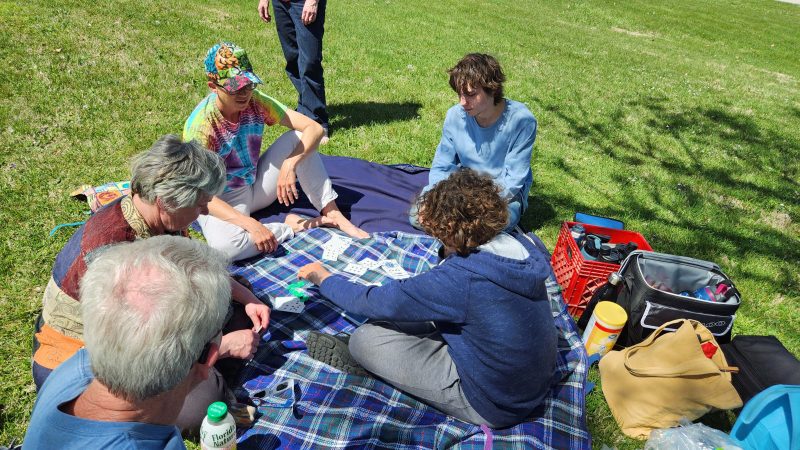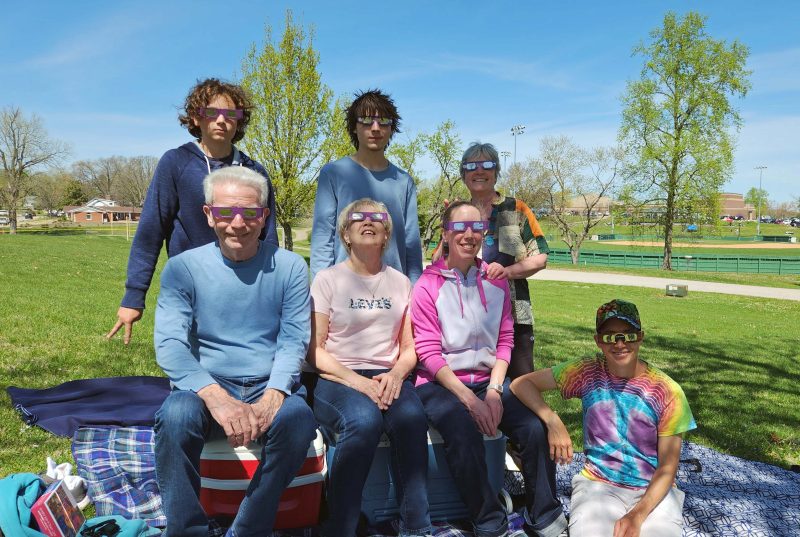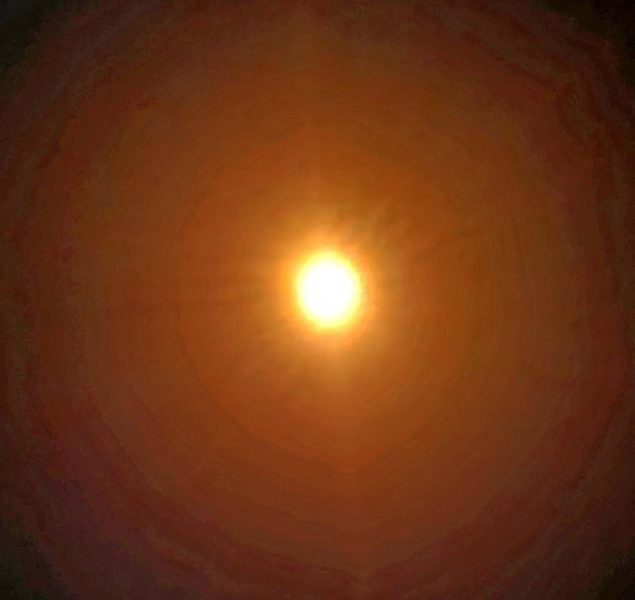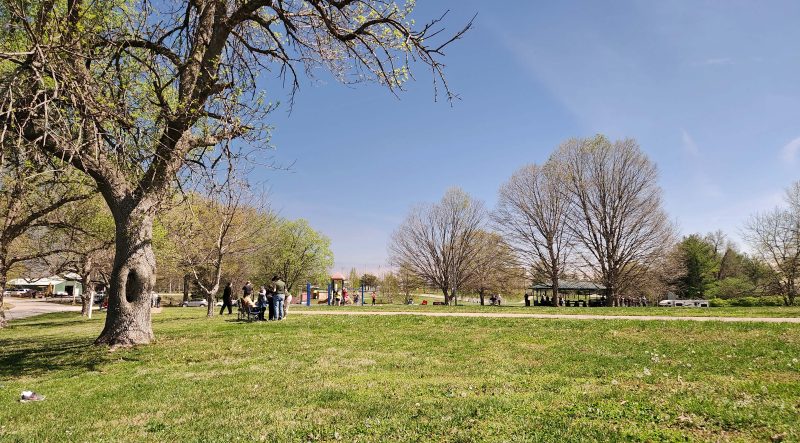On August 21, 2017, Ted and I, Kathy and Annette, and Kari and Dylan saw a total solar eclipse. In spite of weather forecasts for clear skies in Columbia, MO–halfway between Kathy and Annette and the rest of us–thunderstorms moved in, and we re-located eastward to Warrenton, MO to view that eclipse. It was so amazing, we decided right then to reserve August 8, 2024 for another family eclipse viewing.
It doesn’t seem possible that we made those plans seven years ago, but we followed through and planned a day in Perryville, MO for this event. Our same group gathered, and Theo joined us. In 2017, he decided to settle for the near-total eclipse at home with his school classmates, but the rest of us raved so much about the totality that Theo has also been looking forward to the 2024 eclipse for seven years–nearly half his lifetime!
Once again, weather adjustments had to be made for this eclipse, although not by our group. Early information advised the nation that, of the 15 U.S. states in the totality zone, Texas was the most likely to be clear in April; the Midwest was iffy, but probably at least cloudy; and New England was likely to be overcast. In real time, Texas was overcast with thunderstorms in the forecast, and the Midwest and New England were clear. Lucky us!
We liked the way we viewed the eclipse last time in a small park in a small city with a picnic lunch, so we wanted to do that again. Ted and I made a trip to Perryville and to Jackson a few weeks ago to scope out the parks, the bathroom facilities, the viewing spaces, and the parking. Perryville City Park was the winner, so this time, we went to a small city (pop. 8,500), but a large park. It took Ted and me less than two hours to make the scouting drive to Perryville, but there were lots of advance warnings on newscasts and on electronic highway message boards in our area to expect heavy traffic on August 8–eclipse day. We decided an early start was the way to go. We all brought food to share and got an early start to Perryville, leaving home just after 7:30 a.m. for the 1:58 p.m. totality event.
That worked out well. The drive to Perryville on the Big Day took three hours instead of less than two hours, and the traffic was definitely heavier than usual, but it moved along at near the speed limit, and we arrived in plenty of time to easily find a parking spot. Unbelievable! As we were parking our two cars, Ted and I saw our next-door neighbors! We emptied our car trunks, selected our viewing area, and then relaxed for a little while and ate our picnic lunch before the start of the eclipse.



Some nearby eclipse viewers wanted a group photo of themselves and I offered to take it so that everyone in their group could be in the picture. They returned the favor for us.


Before we knew it, the time was 12:30 p.m.–the start of the eclipse. We checked the sky and, sure enough, there was a little bite out of the sun at about five o’clock. Repeated progress checks showed the moon blocking more and more of the sun. Our excitement level was rising. We had some high, thin clouds, but the eclipse was clearly visible through our eclipse glasses. It’s hard to believe, but I took this photo at the 50 percent point.

Between 50 and 75 percent of totality, the light in the park noticeably dimmed and became weird. Even in the sunshine, the blankets we were sitting on felt cool to the touch, there was a sudden cool breeze, and the temperature dropped 8-10 degrees–enough to make us feel chilly.


I put my eclipse glasses over my camera lens and took this picture at about 90 percent totality. The sun is so bright that even a mere 10 percent looks like this. I was hoping the eclipse glasses might show a clear view of the dark moon covering the sun, but cell phones aren’t that good yet. By this time we were all lying on our backs to get the best view of the sky; birds were quieting down; and outdoor lights had come on.

Shortly after this, the only visible part of the sun was a thin crescent, similar to a new moon. At that point, we could watch the crescent become smaller and smaller. As the eclipse approached totality, the park filled with excited voices (including ours), there was an instant of a bright flash when the moon completely blocked the sun from view (the diamond ring), and in that instant, it was as if someone turned off the light switch. Near the end of the video, my camera view becomes erratic because I changed position from lying on my back to sitting up and I forgot my video was still recording. Turn on your sound to hear the excitement, and to watch the sun’s light dim.
In the video, my cell phone camera shows totality as a bright white circle with a black dot in the center. What we really saw was a full moon-size pitch-black circle–the dark side of the moon–surrounded by a strong bright white ring, surrounded by the wispy white corona of the sun. I looked online for pictures that matched what we saw, but I didn’t find any. We (including our resident meteorologist) concluded that the strong white ring was a result of the high clouds over the sun in Perryville. Whatever caused that ring, it was a breathtaking, beautiful sight and the high point of our day. Totality in Perryville lasted a few seconds less than 4 minutes, so we had time to look around and enjoy it. Even so, it ended too soon. Here’s a picture of us in the dark. It’s 2:00 p.m. and the parking lot light is on in the background.

And here’s another picture during totality, but with the camera automatically adjusting the light for a “better” (?) picture.

I took a video of the 360-degree sunset during totality.
About five minutes after totality passed and the sun began to appear, we saw the weirdly-colored sunlight again. It looked like a storm was coming, except that the sky was blue.


When about 30 percent of the sun became visible, things looked more normal, and the sun looked bright again.

We stayed until the sun was fully exposed and then joined the crowds on our way home. Again, traffic moved steadily, just as it did on our way to Perryville–but at 2-7 mph for three hours. We were excited to move forward at 10 mph for an occasional quarter mile before braking again. After three hours of this, we saw a gas station right beside I-55 and decided to stop. It took 15-20 minutes to drive down the exit ramp and cross I-55–about one-quarter mile. There were at least 100+ cars at the gas station and the bathroom line reached the convenience store door with people constantly arriving. This is about half of the gas station parking lot. You can see the backed-up traffic on the road in the right center of the picture. All four directions of this intersection were backed up like that. (Photo credit to Kari for this picture.)

We opened our ice chests and had a snack to fortify ourselves for the rest of our drive, then spent another 15-20 minutes getting back onto I-55. After another hour of slow, but steady, progress–we’d covered 50 miles in 4 hours!–we reached Festus, where I-55 adds a third lane (St. Louis metro area) and were finally able to travel near the speed limit for our last hour home, arriving at about 8:30 p.m. Kathy and Annette live about 3 hours beyond us, but encountered an accident that halted traffic on I-70, so they didn’t get home until 12:30 a.m.
All of us agreed that, if we’d known in advance how bad the traffic would be, we would still go to the eclipse. In 2017, we saw an amazing total solar eclipse, but this one was so-o-o-o much better! It was worth every minute of the experience–even the heavy traffic. The next total solar eclipse will be on August 12, 2026 and will be visible in Iceland. It might be worth making the trip.
P.S.
To celebrate the eclipse, Ted saw this picture of an eclipse snack on the National Weather Service Employees Facebook page. Start at the bottom with the full “sun” and move counterclockwise around the plate to view the Oreo eclipse.
